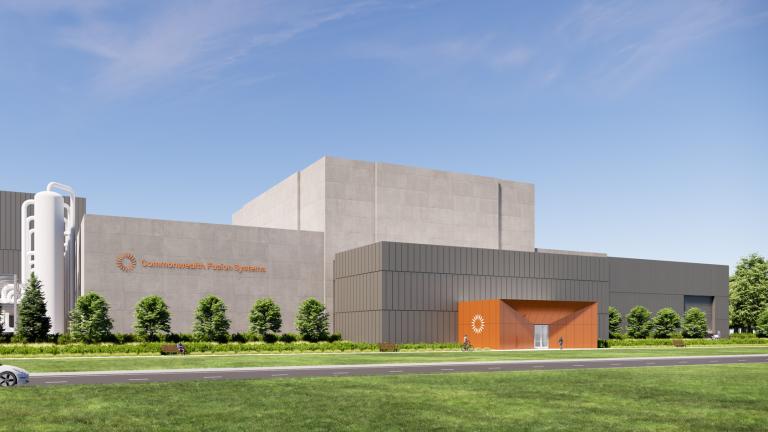
America is one step closer to tapping into a new and potentially limitless clean energy source today, with the announcement from MIT spinout Commonwealth Fusion Systems (CFS) that it plans to build the world’s first grid-scale fusion power plant in Chesterfield County, Virginia.
The announcement is the latest milestone for the company, which has made groundbreaking progress toward harnessing fusion — the reaction that powers the sun — since its founders first conceived of their approach in an MIT classroom in 2012. CFS is now commercializing a suite of advanced technologies developed in MIT research labs.
“This moment exemplifies the power of MIT’s mission, which is to create knowledge that serves the nation and the world, whether via the classroom, the lab, or out in communities,” MIT Vice President for Research Ian Waitz says. “From student coursework 12 years ago to today’s announcement of the siting in Virginia of the world’s first fusion power plant, progress has been amazingly rapid. At the same time, we owe this progress to over 65 years of sustained investment by the U.S. federal government in basic science and energy research.”
The new fusion power plant, named ARC, is expected to come online in the early 2030s and generate about 400 megawatts of clean, carbon-free electricity — enough energy to power large industrial sites or about 150,000 homes.
The plant will be built at the James River Industrial Park outside of Richmond through a nonfinancial collaboration with Dominion Energy Virginia, which will provide development and technical expertise along with leasing rights for the site. CFS will independently finance, build, own, and operate the power plant.
The plant will support Virginia’s economic and clean energy goals by generating what is expected to be billions of dollars in economic development and hundreds of jobs during its construction and long-term operation.
More broadly, ARC will position the U.S. to lead the world in harnessing a new form of safe and reliable energy that could prove critical for economic prosperity and national security, including for meeting increasing electricity demands driven by needs like artificial intelligence.
“This will be a watershed moment for fusion,” says CFS co-founder Dennis Whyte, the Hitachi America Professor of Engineering at MIT. “It sets the pace in the race toward commercial fusion power plants. The ambition is to build thousands of these power plants and to change the world.”
Fusion can generate energy from abundant fuels like hydrogen and lithium isotopes, which can be sourced from seawater, and leave behind no emissions or toxic waste. However, harnessing fusion in a way that produces more power than it takes in has proven difficult because of the high temperatures needed to create and maintain the fusion reaction. Over the course of decades, scientists and engineers have worked to make the dream of fusion power plants a reality.
In 2012, teaching the MIT class 22.63 (Principles of Fusion Engineering), Whyte challenged a group of graduate students to design a fusion device that would use a new kind of superconducting magnet to confine the plasma used in the reaction. It turned out the magnets enabled a more compact and economic reactor design. When Whyte reviewed his students’ work, he realized that could mean a new development path for fusion.
Since then, a huge amount of capital and expertise has rushed into the once fledgling fusion industry. Today there are dozens of private fusion companies around the world racing to develop the first net-energy fusion power plants, many utilizing the new superconducting magnets. CFS, which Whyte founded with several students from his class, has attracted more than $2 billion in funding.
“It all started with that class, where our ideas kept evolving as we challenged the standard assumptions that came with fusion,” Whyte says. “We had this new superconducting technology, so much of the common wisdom was no longer valid. It was a perfect forum for students, who can challenge the status quo.”
Since the company’s founding in 2017, it has collaborated with researchers in MIT’s Plasma Science and Fusion Center (PFSC) on a range of initiatives, from validating the underlying plasma physics for the first demonstration machine to breaking records with a new kind of magnet to be used in commercial fusion power plants. Each piece of progress moves the U.S. closer to harnessing a revolutionary new energy source.
CFS is currently completing development of its fusion demonstration machine, SPARC, at its headquarters in Devens, Massachusetts. SPARC is expected to produce its first plasma in 2026 and net fusion energy shortly after, demonstrating for the first time a commercially relevant design that will produce more power than it consumes. SPARC will pave the way for ARC, which is expected to deliver power to the grid in the early 2030s.
“There’s more challenging engineering and science to be done in this field, and we’re very enthusiastic about the progress that CFS and the researchers on our campus are making on those problems,” Waitz says. “We’re in a ‘hockey stick’ moment in fusion energy, where things are moving incredibly quickly now. On the other hand, we can’t forget about the much longer part of that hockey stick, the sustained support for very complex, fundamental research that underlies great innovations. If we’re going to continue to lead the world in these cutting-edge technologies, continued investment in those areas will be crucial.”






